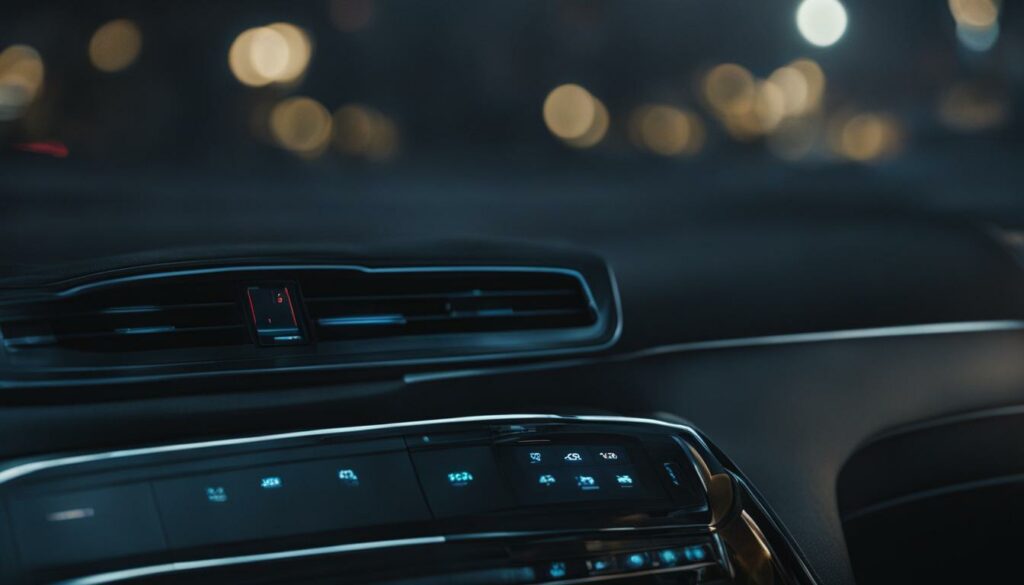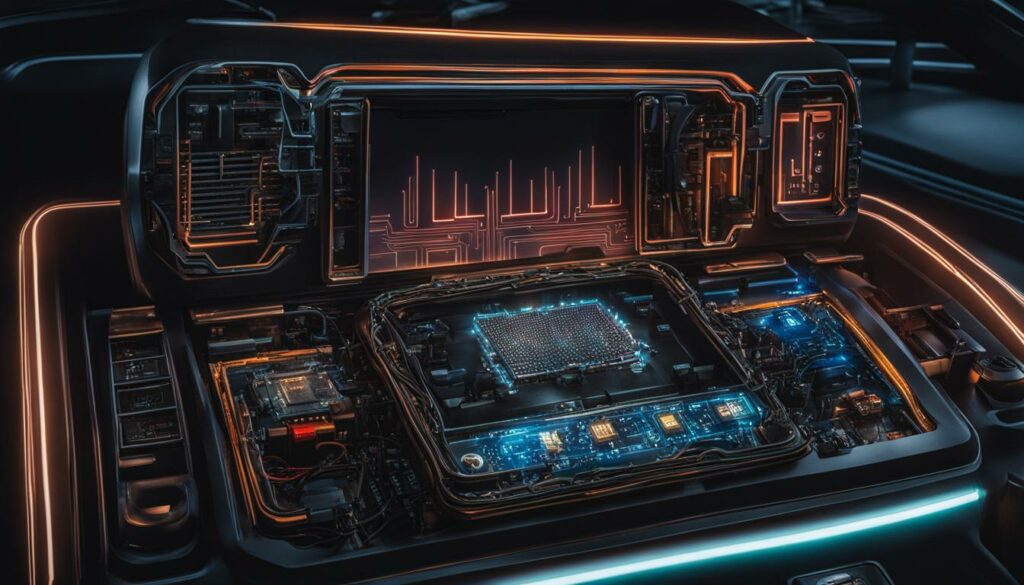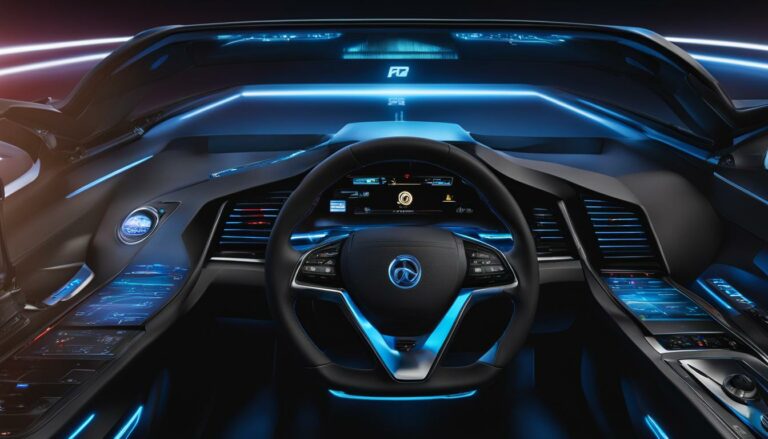If you recently replaced your car battery and are experiencing electrical problems, you’re not alone. It’s common to face issues with your car’s electrical system after a battery replacement. However, it’s crucial not to ignore these problems and address them immediately to avoid any safety hazards.
In this section, we will guide you through the most common electrical problems that may arise after replacing your car battery. We’ll also provide troubleshooting tips to help you identify and resolve these issues effectively.
Key Takeaways:
- Replacing your car battery can cause electrical issues in your vehicle.
- It’s essential to address these problems immediately to avoid safety hazards.
- Our troubleshooting tips will help you identify and resolve common electrical issues.
Understanding the Importance of a Healthy Car Battery
Before delving into troubleshooting electrical problems, it’s crucial to understand the significance of a healthy car battery. A healthy battery is essential for the proper functioning of your vehicle’s electrical system, as it provides the necessary power to start the engine and keep all other electrical components running.
If your battery is not in good condition, it can cause a myriad of problems, ranging from sluggish performance to complete electrical failure. In fact, a weak or dead battery is one of the most common reasons for a car not starting.
Regular maintenance and inspection of your car battery can go a long way in ensuring it remains in good health. It’s recommended to have your battery checked by a professional mechanic at least once a year. Additionally, you can perform some simple checks yourself, such as inspecting the connections for corrosion and ensuring they are tight.
If you suspect that your battery is not functioning properly, it’s best to get it replaced as soon as possible. A quality replacement battery can help to prevent future electrical problems and ensure reliable performance for your vehicle.
Identifying the Symptoms of Electrical Problems
Electrical problems can cause various symptoms in your car. Identifying these symptoms can help you pinpoint the problem and take the right course of action. Here are some common signs that indicate electrical issues:
- Dimming headlights: If your headlights are flickering or dimming, it could be a sign of a weak battery or a failing alternator.
- Malfunctioning electronics: If the radio, power windows, or other electronics are not functioning correctly, it could be a sign of a faulty fuse or a wiring issue.
- Dead battery: If your battery is not holding a charge, it could be a sign of a bad alternator or a parasitic drain on the battery.
- Burning smell: If you detect a burning smell, it could be due to an overheating wire or a failing component.
- Strange noises: If you hear unusual clicking or buzzing noises coming from your car, it could be a sign of a damaged electrical component.
Being aware of these symptoms can help you take quick action and prevent further damage to your car’s electrical system.
Common Misdiagnoses of Electrical Problems
Some electrical problems can be misdiagnosed, leading to unnecessary repairs or replacements. Here are some common misdiagnoses to watch out for:
- Assuming a dead battery means a bad alternator
- Assuming a bad starter means a bad battery
- Assuming a bad fuse means a faulty component
It’s essential to diagnose the problem correctly to avoid wasting time and money on unnecessary repairs. If you’re unsure about the problem, it’s best to seek professional help.

Checking for Loose or Corroded Battery Connections
Loose or corroded battery connections are a common cause of electric problems in your car.
To check your battery connections, follow these simple steps:
- Locate the battery: Many modern vehicles have the battery located under the hood, while some others have it in the trunk. Check your owner’s manual if you’re unsure where to find it.
- Visually inspect the connections: Check the battery terminals and cables for any signs of corrosion, such as white or greenish deposits. Also, check for any loose connections, which can affect the power flow.
- Tighten the connections: If you find any loose connections, use a wrench or pliers to tighten them. However, be careful not to overtighten them as it can result in damaged threads or broken bolts.
- Clean the connections: If you see any signs of corrosion, use a wire brush to clean the terminals and cables. You can also use baking soda and water or a specialized cleaner to remove the deposits.
- Reconnect the battery: Once you have cleaned and tightened the connections, reconnect the battery and make sure it’s properly secured.
If you have a severe corrosion issue, you may need to replace the battery cables. However, it’s always recommended to seek professional assistance in such cases.
Remember, loose or corroded battery connections can prevent your car from starting or may cause it to stall while driving. So, it’s crucial to inspect them regularly to avoid any electrical problems.
Checking for loose battery connections and corrosion is crucial to avoid electric problems in your vehicle.
Resetting the Car’s Computer System
Resetting your car’s computer system is a quick and simple process that can help resolve some electrical problems. It clears the vehicle’s memory, erasing any stored error codes and restoring default values to the system.
To reset the computer system, follow these steps:
- Disconnect the negative cable from your car’s battery using a wrench. It’s important to do this before attempting any electrical repairs to avoid any potential electrical shock or damage.
- Turn on your headlights. This helps discharge any remaining electrical current in the system.
- Leave the headlights on for at least 15 minutes.
- Turn off the headlights and reconnect the negative battery cable.
Once you have reset the computer system, take your car for a test drive to see if the issue has been resolved. If the problem persists, it’s best to seek professional help.
Keep in mind that not all electrical problems can be fixed by resetting the computer system. In some cases, the issue may lie in the wiring, battery, or alternator. If you continue to experience electrical problems after resetting the system, it’s best to move on to the other troubleshooting steps outlined in this article.

Remember, always make sure to disconnect the negative battery cable before attempting any electrical repairs. Safety should always be your top priority.
Testing and Replacing Fuses
If your car battery is in good condition and the connections are secure, the next step in troubleshooting electrical problems is to check the fuses. Faulty fuses can disrupt the electrical flow in your car, causing various issues. Here’s how you can test and replace fuses to ensure they are not the cause of your troubles.
Testing Fuses
Before testing fuses, make sure your car is turned off and the keys are removed from the ignition.
Using a fuse tester, check each fuse in the fuse box to see if it’s still functional. Alternatively, you can use a multimeter to test the fuse. Set the multimeter to the lowest ohms scale and place the test probes on each side of the fuse. If the reading is zero or close to zero, the fuse is still good. If the reading is infinite, the fuse needs to be replaced.
Replacing Fuses
If you find a blown fuse, it’s time to replace it. Refer to your car owner’s manual to locate the fuse box and determine which fuse needs to be replaced. Once you’ve located the fuse, use a fuse puller or a pair of pliers to carefully remove it from its slot. Then, insert a new fuse of the same amperage rating and test to see if the electrical issue has been resolved.
Note: Never replace a fuse with one that has a higher amperage rating, as this can cause severe electrical damage to your car.
By testing and replacing fuses in your car’s electrical system, you can ensure they are not the cause of your problems. However, if you continue experiencing issues, it’s best to move on to other troubleshooting steps or seek professional assistance.
Checking the Alternator’s Functionality
If you’ve ruled out loose or corroded battery connections as the cause of your electrical problems, the next component to check is the alternator. The alternator is responsible for charging your car battery while the engine is running and powering all electrical systems.
The first step in checking the alternator’s functionality is to perform a visual inspection of the alternator belt. Make sure it’s properly tensioned and not excessively worn or cracked. If the belt looks good, you can perform a simple test using a digital multimeter to measure the alternator’s output voltage.
To do this, start the engine and let it idle while you set your multimeter to DC volts. With the engine running, touch the positive lead of the multimeter to the positive battery terminal and the negative lead to the negative terminal. A healthy alternator should provide a reading of around 13.8 to 14.4 volts.
If your multimeter reads below this range, the alternator may not be providing enough charge to the battery, causing your electrical problems. On the other hand, if the reading is above this range, the alternator may be overcharging the battery, which can also cause damage to the electrical system.
If you suspect that your alternator is faulty, it’s best to take your car to a professional mechanic to have it properly diagnosed and repaired. Replacing an alternator can be a complicated and potentially dangerous process that requires specialized tools and knowledge.
Inspecting the Wiring and Ground Connections
If you have checked the battery connections, fuses, and the alternator, but the electrical problems persist, it’s time to inspect the wiring and ground connections. Damaged or loose wiring can cause electrical issues, and faulty ground connections can prevent the electrical systems from working correctly.
To inspect the wiring, start by checking the wiring diagram for your car’s model and year. The wiring diagram shows the electrical components’ locations and how they are connected. You can find it in your vehicle’s manual or online.
Next, visually inspect all wiring for any signs of damage, such as frayed wires or exposed insulation. You should also check for loose connections, as they can cause electrical problems. Tighten any loose connections and reattach any disconnected wires.
If you find damaged wiring, it should be promptly repaired or replaced. To do this, you may need to strip the wire, cut a new one to the appropriate length, and attach it to the original connector. It’s essential to match the wire gauge and amperage rating to the original wire. Any modifications made must be done with caution to avoid any damage to other components.
After you have checked and repaired the wiring, inspect the ground connections. A ground wire is responsible for the flow of electricity from the battery to the electrical components. Locate the ground connections by referring to the wiring diagram in your vehicle’s manual or online.
Visually inspect the ground connections for any corrosion or damage. Clean any corroded connectors with a wire brush and reconnect them. You should also check the ground wire for any sign of damage, such as fraying or wear, and replace it if necessary.
In summary, inspecting the wiring and ground connections is an essential step in troubleshooting electrical problems. If you find any damage or loose connections, repair or replace them immediately. Refer to the wiring diagram to identify all components and their locations, and match wires correctly if modifications are needed. Keep in mind that if you’re not comfortable with inspecting or repairing the wiring yourself, it’s best to seek the help of a professional mechanic to avoid any further damage or safety issues.
Seeking Professional Assistance
If you have tried the troubleshooting steps outlined in the previous sections and are still experiencing electrical problems, it may be time to seek professional assistance. A qualified mechanic can diagnose the issue and offer a solution that may require specialized equipment and expertise.
Professional assistance can be especially helpful if the problem is complex or requires the replacement of expensive parts. An experienced mechanic can also help prevent future issues by identifying potential problems before they cause significant damage.
It’s important to choose a reputable mechanic with the necessary knowledge and credentials to address electrical problems. Look for certifications from organizations such as the National Institute for Automotive Service Excellence (ASE) and ask for recommendations from friends and family.
Keep in mind that seeking professional assistance can be more expensive than attempting to fix the problem yourself. However, the cost of a professional repair may be worth it if it ensures your safety on the road and prevents expensive damage to your car.
Remember, safety should always be your priority. Don’t hesitate to seek professional assistance if you feel uncertain or uncomfortable working with automotive electrical systems.
You may also like to check:
Guide on How to Reset Car Alarm After Battery Change
Do You Have to Reset Car Computer After Replacing Battery?
Does Car Battery Affect Air Conditioning? Your Guide.
Can Car Battery Die While Driving? Discover the Facts!
Can a Car Battery Get Wet? Find Out!
How to Unlock a Steering Wheel with a Dead Battery: Step-by-Step Guide
Conclusion
Replacing a car battery is a relatively straightforward process, but it can cause electrical problems if not done carefully. If you’re experiencing issues after replacing your battery, it’s essential to identify the cause and address it promptly. Start by understanding the importance of a healthy car battery and recognizing the symptoms of electrical problems.
If the issue lies with loose or corroded battery connections, be sure to inspect and tighten or clean them as necessary. Resetting the car’s computer system is also worth a try, as it can often resolve minor electrical issues. Testing and replacing faulty fuses, checking the alternator’s functionality, and inspecting the wiring and ground connections are other troubleshooting steps you can take.
If you have tried all the troubleshooting options outlined in this article without success, it may be time to seek professional assistance. Consulting a professional mechanic can save you time, money, and frustration in the long run.
Remember to prioritize your safety and the safety of others when dealing with electrical problems in your vehicle. Follow the steps outlined in this article and seek professional help if needed. With the right knowledge and guidance, you can effectively troubleshoot and resolve common electrical problems after replacing your car battery.








